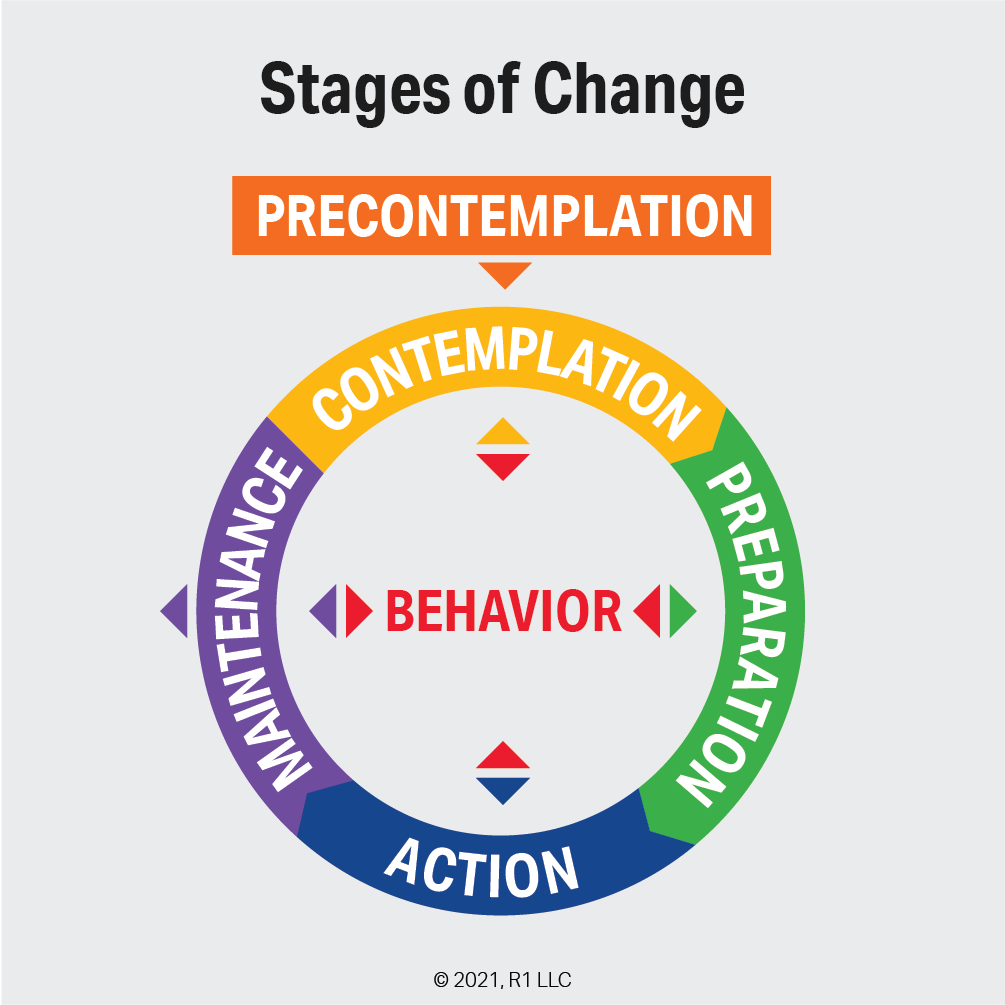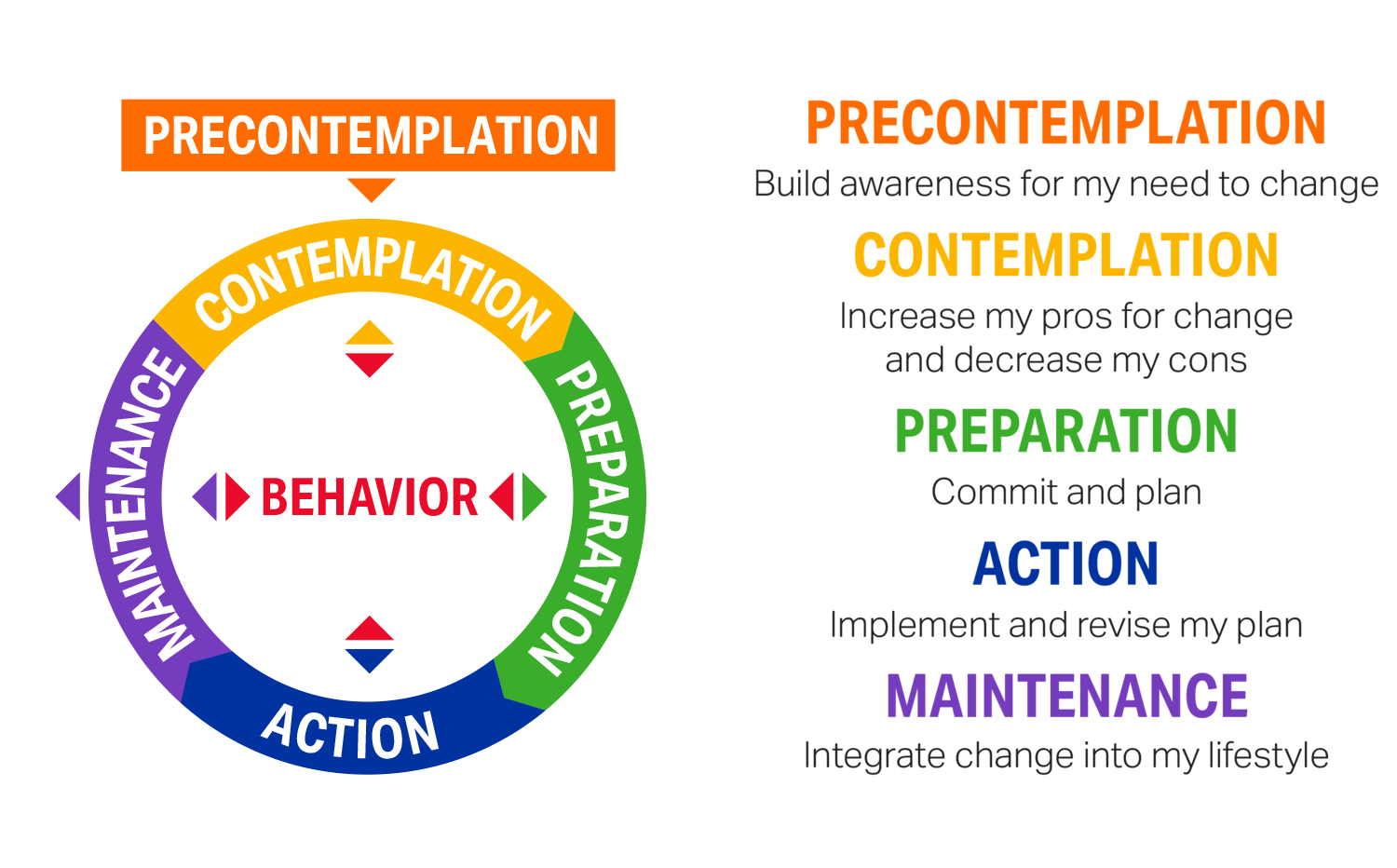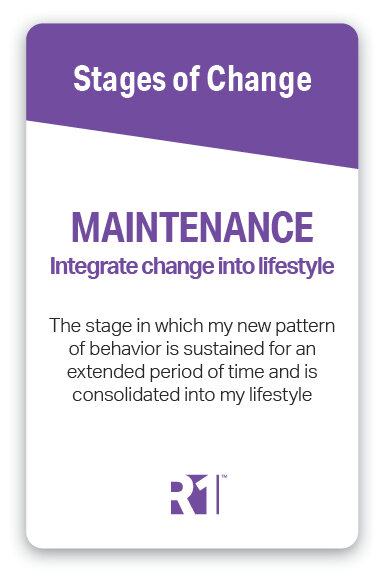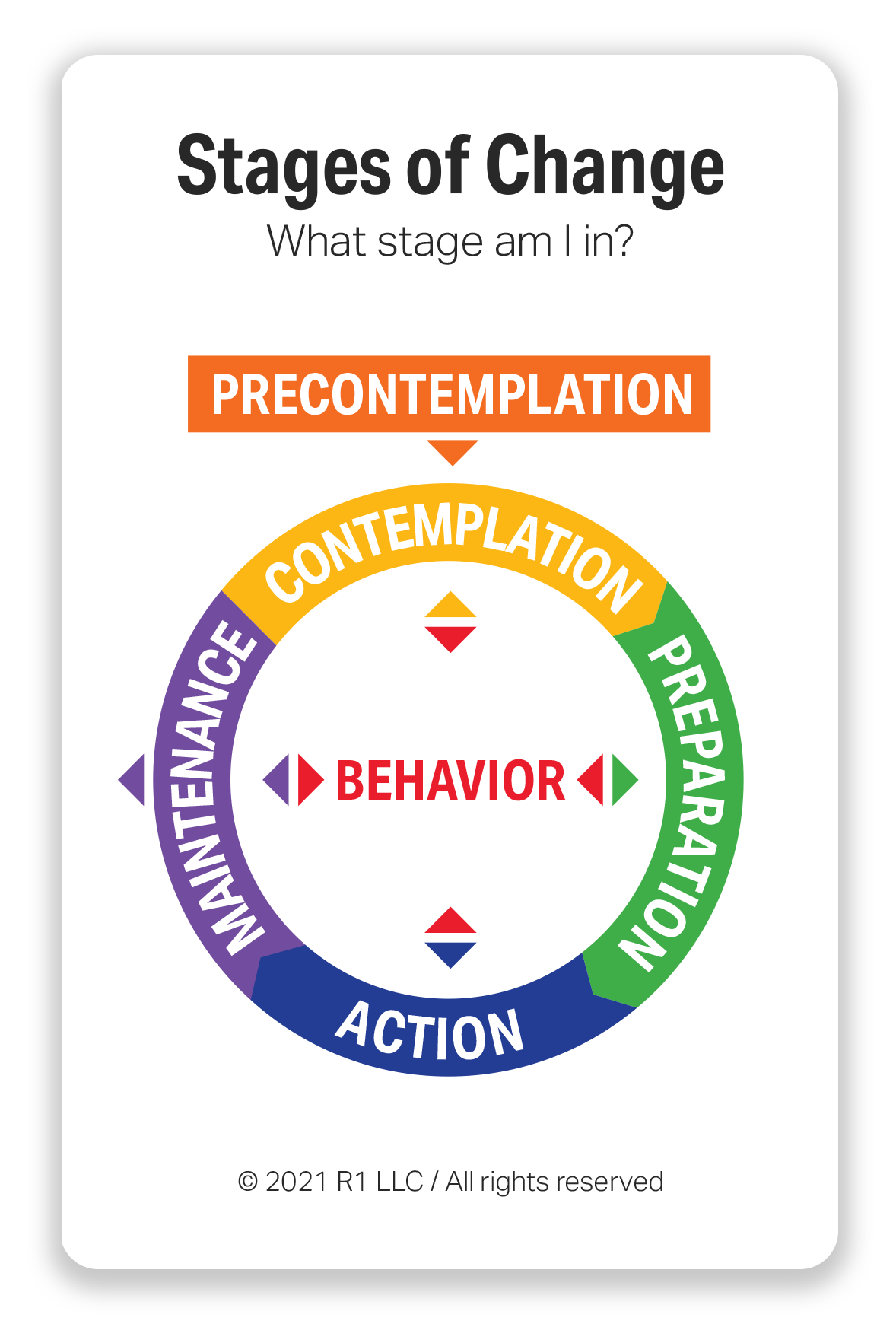What Is The Transtheoretical Model Of Change
The 5 Stages of Change and the Transtheoretical Model (TTM) — Do Yous Know the Basics?

Didactics others to larn and apply the fundamentals of behavioral health evidence-based theories and all-time practices is why R1 Learning exists. Our mission is to curate the most impactful work from experts in the field and put them into the easily of practitioners (clinicians, counselors, coaches, and educators) at all levels of noesis, skills, and experience, and increase their effectiveness. Our goal is as well to put these same theories and tools into the hands of individuals in treatment and recovery and then that they can sympathize them more than quickly and concretely, and empower them to change toward healthier behavior. Stages of Modify was the first topic nosotros identified for the R1 Learning System. It was our offset Discovery Cards Deck and Grouping Kit thanks to the gracious support and review past Drs. Prochaska (James and Janice) and DiClemente (Carlo). Information technology is a fundamental trunk of noesis and ane that we think will stand the exam of time for decades to come up. Our goal for today'southward post is that y'all will walk away with the fundamentals of the Stages of Change and exist able to apply it in your next 1-on-1 or group session. Let's start with the nuts… what is change?
Change — the human activity or process of transforming, shifting, or becoming dissimilar in nature
Modify is one of the well-nigh difficult behavioral processes. Why and how exercise people change? What is the role of motivation in the modify procedure? Extensive inquiry has been conducted to answer such questions.
The Change Procedure. Research has noted that modify is a process. Change is rarely a single moment in fourth dimension. It occurs
over time. It has stages and processes. To better understand and illustrate how change occurs, researchers often develop
models and theories. A pair of researchers — Drs. James Prochaska and Carlo DiClemente — closely examined theories well-nigh how people change. They also developed a model based on the body of work they studied. Considering their model emerged from reviewing multiple psychological and behavioral theories virtually how change occurs, they described their biopsychosocial framework for understanding addiction as "transtheoretical." Their Transtheoretical Model (TTM) of Change explains that the change process is a sequence of stages through which people progress as they consider, kickoff, and maintain new behaviors. Drs. Prochaska and DiClemente refer to the Stages of Change Model as a way of illustrating the change process, understanding what phase individuals are progressing through, and identifying strategies that enhance individuals' motivation to progress to the next stage.
The TTM, and peculiarly the Stages of Change Model, is ane of the leading models in behavioral health and has been applied to many different behavioral health issues beyond its original focus in smoking abeyance. Because of the TTM's focus on the behavioral change processes, it is well suited to the treatment of habitual and addictive behaviors. It has been successfully applied to addiction and substance utilise disorders. There have been countless books, articles, and evidence-based research studies on the Stages of Change. Its research base and application are then extensive that it has been a challenge to distill it to its simplest course for this post and for application with the Discovery Cards. Our objective is to give you the basics of the TTM and encourage you to seek out more information from the reference list included at the cease of this post likewise as other sources. We hope you will leverage what we provide below, explore the referenced resources, and add together information technology as a model and tool for your work with individuals.
The Transtheoretical Model — Drs. Prochaska & DiClemente

Copyright 2020 R1 LLC
The Transtheoretical Model (TTM) is an integrative, biopsychosocial model used to anticipate the procedure of intentional behavior change — that is, an private'south readiness to act on new, healthier behavior. Whereas other models of behavior modify focus on just 1 dimension of change (for example, they focus mainly on social factors, or psychological problems, or physical aspects), the TTM combines the near effective components from other theories into a comprehensive model of change. Its proper name spells out what it is: the prefix trans ways across, and theoretical means concerned with the theory of a subject or area of study — hence, the term transtheoretical. The TTM has been applied successfully in a variety of behaviors, populations, and settings. The following iv constructs of the TTM are required for progress toward recovery:
-
Stages of Change — the progression of stages through which individuals laissez passer as they change their beliefs
-
Processes of Change — strategies to help individuals make and maintain change — the "how" of modify
-
Decisional Balance — a growing sensation that the advantages (the "pros") of changing outweigh the disadvantages (the "cons")
-
Self-efficacy — confidence that one can make and maintain changes in situations that could trigger a return to previous unhealthy behaviors
We will briefly describe each of these four constructs of the TTM in more than detail below:
1. Stages of Change Divers

The TTM recognizes change as a procedure that unfolds over fourth dimension, involving progress through a series of stages. According to the TTM, individuals motion through a series of 5 stages — precontemplation, contemplation, training, activeness, and maintenance — in the adoption of healthy behaviors or the cessation of unhealthy ones. These stages are defined beneath. While progression through the stages of modify tin occur in a linear fashion, a nonlinear progression is common. Often, individuals recycle through the stages or backslide to earlier stages from subsequently ones. Although the fourth dimension a person stays in each stage is variable, the tasks required to motion to the next phase are not. Certain principles and processes of alter come into play at each phase to reduce resistance, facilitate progress, and prevent relapse. Those principles include processes of change, decisional balance, and self-efficacy (more than on these below). Only a minority (usually less than 20%) of at-risk individuals are prepared to take action toward alter at whatever given time. Equally a result, action-oriented guidance can miss serve individuals in the early stages, as they may not be ready to take activity. At each Stage of Change, there are specific intervention strategies that are most effective at helping the individual motion to the next stage of change and subsequently through the model to the Maintenance Stage, which is the goal.

Individuals in the Precontemplation Stage practise non intend to quit and outset more salubrious beliefs in the near future (within 6 months) and may be unaware of the demand to change. They typically underestimate the pros of irresolute, overestimate the cons, and are often non aware of this mindset. Individuals in this phase need to be more mindful of their decision-making and more than conscious of the multiple benefits of changing their unhealthy behavior. Discovery Cards examples include:
-
I don't remember I could quit even if I wanted to
-
I don't want to be told what to exercise regarding my drinking or using
-
I haven't experienced any serious consequences every bit a consequence of my drinking or using
-
I actually don't see many benefits to quitting

Individuals in the Contemplation Stage intend to quit and start more good for you beliefs within the side by side six months. While they are usually now more aware of the pros of changing, their cons are about equal to their pros. This ambiguity most changing can cause them to go along putting off taking activeness. Individuals in this stage learn about the benefits of modify and the kind of person they could be if they quit and inverse their behavior to more than healthy means. Discovery Cards examples include:
-
I see how my drinking or using tin can hurt others
-
I am noticing people who have quit and they seem healthier and happier
-
I remember I may experience more serious consequences if I don't quit shortly
-
I think I might be healthier and happier if I quit

Individuals in the Training Stage are ready to start taking action within the next 30 days. They take small steps that they believe tin help them quit and make the salubrious behavior a part of their lives. It is helpful for individuals in this phase to seek back up from friends they trust, tell people about their plan to change, and recall about how they would feel if they behaved in a healthier fashion. Their number one concern is: When they deed, volition they fail? They learn that the better prepared they are, the more probable they are to keep progressing. Discovery Cards examples include:
-
I am planning means to cutting downward or quit
-
I am seeking resource that volition help me quit
-
I am ready to set a quit date
-
I believe that others will help me quit if I enquire them to

Individuals in the Action Stage accept changed their behavior inside the last 6 months and demand to work difficult to continue progressing in recovery. Individuals in this stage need to learn how to strengthen their commitments to change and to fight urges to sideslip back that may cause them to relapse. They progress by learning to substitute activities related to the unhealthy beliefs with positive ones, rewarding themselves for taking steps toward changing, and avoiding people, places, things, and situations that tempt them to behave in unhealthy ways. Discovery Cards examples include:
-
I am asking others for aid
-
I am avoiding people, places, things, and situations that trigger me to beverage or use
-
I am connecting with others and building a new network of sober friends
-
I am rewarding myself for quitting

Individuals in the Maintenance Phase take changed their beliefs for more than than half dozen months. It is important for people in this stage to be enlightened of situations that may tempt them to slip back into doing the unhealthy beliefs — specially stressful situations. Individuals in this stage are best served when they seek back up from and talk with people whom they trust, spend time with people who deport in healthy ways, and remember to engage in healthy activities to cope with stress instead of relying on unhealthy beliefs. Discovery Cards examples include:
-
I am going to continue to not drink or utilise — I enjoy sobriety
-
I am grateful for quitting and living a sober life
-
I am serving and supporting others in recovery
-
I have accustomed that I am in recovery
2. The Processes of Change Defined
While the Stages of Change are useful in explaining when changes in cognition, emotion, and behavior take place, the Processes of Change assist to explain how those changes occur. These ten processes, which are defined below the table, tin enable individuals to successfully progress through the Stages of Modify when they effort to modify problem behaviors and
achieve desired beliefs change. The Processes of Modify can exist divided into two groups: 1) cerebral and melancholia processes
and ii) behavioral processes. Co-ordinate to research on the TTM conducted past Drs. Prochaska and DiClemente and their
colleagues, interventions to change behavior are more than constructive if they are "stage-matched" — that is, interventional
techniques related to the specific processes are matched to the Phase of Alter that individual is in. The table below
shows the Processes of Alter matched to the Stages of Change, with color bars indicating the processes employed as
individuals move through stages.
Processes Matched to Stages - The Processes of Modify employed by individuals to move through the Stages of Change

-
Consciousness-Raising — build sensation: Individuals increment awareness through information, educational activity, and feedback most their electric current pattern and behavior, and/or their potential new behavior
-
Emotional Arousal / Dramatic Relief — pay attention to emotions and feelings: Individuals feel fear or feet considering of their unhealthy behavior, or feel inspiration and hope when they hear near how people are able to change to new salubrious patterns and behavior
-
Self-Reevaluation — create a new positive cocky-image: Individuals clarify values and realize that the new healthy pattern and behavior are an important part of who they are and aspire to exist
-
Environmental Reevaluation — notice impact on others: Individuals realize how their unhealthy pattern and beliefs negatively affect others and how they could accept more positive effects past irresolute their beliefs
-
Social Liberation — observe public back up and gain alternatives: Individuals realize that gild is more supportive of their new healthier behavior
-
Self-Liberation — make choices and commitments: Individuals believe in their power to change and brand choices, commitments, and re-commitments to act on their belief and stay the course in their recovery
-
Counterconditioning — use substitutes: Individuals substitute new salubrious ways of thinking and interim for unhealthy patterns and behavior
-
Stimulus Control — observe and manage environment: Individuals employ reminders and cues that encourage healthy behavior as substitutes for those that encourage unhealthy patterns and beliefs
-
Helping Relationships — get help and support: Individuals discover people who support their new salubrious behavior
-
Reinforcement Management — apply rewards: Individuals increase the rewards that come from positive healthy beliefs and decrease those that come up from negative unhealthy behavior
three. Decisional Balance Defined

Tipping the Balance Toward Change. When people make decisions, they weigh the costs and benefits of their dissimilar choices. Decision-making was conceptualized by Janis and Mann (1977) as a decisional "remainder canvass" of potential gains and losses. Ii components of decisional remainder, the pros and the cons, have become core parts of the Transtheoretical Model (TTM). As individuals progress through the Stages of Change, decisional residuum shifts in critical ways. When an individual is in the Precontemplation Stage, the pros for behavior change are outweighed by the cons, and the balance is in favor of maintaining the existing unhealthy behavior. In the Contemplation Stage, the pros and cons tend to carry equal weight, leaving the individual clashing about modify. Equally the decisional residual is tipped such that the pros for changing outweigh the cons for maintaining the unhealthy behavior, many individuals move to the Training or even the Action Stage. As individuals enter the Maintenance Stage, the pros for maintaining the healthy behavior change should outweigh the cons of maintaining that modify and thus decrease the risk of relapse.
4. Self-Efficacy Defined

Building Conviction Toward Change. Cocky-efficacy is a belief in our ain competence to successfully accomplish a task and produce a favorable outcome. Cocky-efficacy plays a major part in determining one'south success — individuals with high self-efficacy are more likely to put forth sufficient try that leads to successful outcomes; those with low self-efficacy are more probable to finish efforts early on and fail. The TTM integrates elements of Bandura's self-efficacy theory (Bandura 1977, 1982). This construct reflects the degree of confidence individuals accept in maintaining their desired behavior change in situations that often trigger relapse. Information technology is also measured by the caste to which individuals feel tempted to return to their problem behavior in high-risk situations. In the Precontemplation and Contemplation Stages, temptation to appoint in the problem behavior is far greater than self-efficacy to abjure from that problem behavior. As individuals motility from Preparation to Activity, the disparity between feelings of cocky-efficacy and temptation closes, and behavior change is attained. Relapse often occurs in situations where feelings of temptation trump individuals' sense of self-efficacy to maintain the desired behavior change.
Disquisitional Assumptions of the TTM
The TTM is based on critical assumptions about the nature of behavior modify and interventions that tin can best facilitate
such change:
-
Beliefs change is a process that unfolds over time through a sequence of stages.
-
Stages are both stable and open to alter, just as chronic behavior risk factors are both stable and open to change.
-
Interventions tin motivate change by enhancing the agreement of the pros and diminishing the value of the cons.
-
Near at-run a risk individuals are not prepared for activeness and will not be served by traditional action-oriented prevention programs. Helping individuals set realistic goals, like progressing to the next phase, will facilitate the change procedure.
-
Specific principles and processes of change need to be matched with specific stages of change for progress through the stages to occur.
Copyright 2020 R1 LLC / All Rights Reserved. Utilise of this article for any purpose is prohibited without permission.
Questions to Explore
Answer these questions for yourself or someone y'all are working with.
-
Do you discover this model helpful in thinking about your feel counseling / coaching clients with substance use?
-
Do the stages make sense to you? Are the categories helpful and easy to understand?
-
Which Discovery Cards behaviors resonate mostly with yous every bit you read the examples?
-
As you look back over relevant counseling / coaching experiences, do you see how individuals move through the stages?
-
Exercise you see how individuals get stuck in sure stages? What keeps them stuck? How can you help them proceed progressing through the stages?
-
How tin can you incorporate Motivational Interviewing (MI) techniques with the Stages of Change model and behaviors? What questions tin you inquire for each of the Discovery Carte examples above when these behaviors show up?
-
How can you lot incorporate these ideas into your next one-on-ane or group session?

The R1 Challenge: Thank you for reading this post and participating in this activity. How did y'all do? On a scale of 1 to 10, how would you rate your level of knowledge most this topic prior to reading our post? What is your level now? We hope yous were able to walk away with at least 1 new learning or insight. Delight share this post with your team and so they can test their knowledge also. Contact u.s. if you would like to learn more about the Stages of Change Group Kits or the R1 Learning Organisation. We look frontward to hearing from you lot.
Facilitate Engaging Group Activities
Stages of Change Discovery Cards and Group Kits – Appointment Tools
Integrating these tools into your groups will permit individuals to build their ain vocabulary, think well-nigh these concepts concretely, and put their choices into activity. Visit the R1 Store to learn more than about these evidence-based behavioral topics and models. The cards are an amazing tool for exploring these topics with individuals or groups.
References
Bandura A. "Cocky-Efficacy Machinery in Human Agency." American Psychologist 37:122–147, 1982.
Bandura A. "Self-Efficacy: Toward a Unifying Theory of Behavioral Change." Psychological Review 84:191–215, 1977.
DiClemente CC. Addiction and Alter. New York, Guilford Press, 2018.
Janis IL, Isle of mann L. Determination Making: A Psychological Assay of Conflict, Selection, and Commitment. New York, Free Printing, 1977.
Prochaska JO, Prochaska JM. Changing to Thrive. Center Urban center, MN, Hazelden Publishing, 2016.
Prochaska JO, DiClemente CC, Norcross JC. "In Search of How People Change: Applications to the Addictive Behaviors." American Psychologist 47:1102–1114, 1992.
Prochaska JO, DiClemente CC. "Stages and Processes of Self Change of Smoking: Toward an Integrative Model of Change." Journal of Consulting and Clinical Psychology 51:390–395, 1983.
Velasquez MM, Maurer G, Crouch C, DiClemente CC. Group Handling for Substance Corruption: A Stages-of-Change Therapy Manual. New York, Guilford Press, 2001.
Here are a few ideas to assist you learn more than well-nigh R1 and engage others on this topic:
-
Share this blog post with others. (Cheers!)
-
Start a conversation with your team. Bring this information to your next team meeting or share it with your supervisor. Modify starts in conversations. Good luck! Let us know how information technology goes.
-
Visit world wide web.R1LEARNING.com to learn moreabout R1, the Discovery Cards, and how we're creating engaging learning experiences through self-discovery.
Source: https://r1learning.com/blog/2020/5-stages-of-change
Posted by: bynumraimad.blogspot.com


0 Response to "What Is The Transtheoretical Model Of Change"
Post a Comment